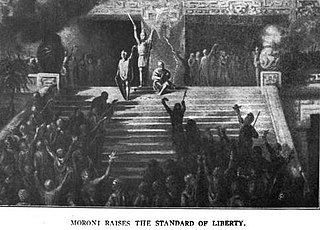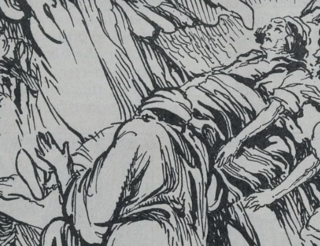
The Book of Alma: The Son of Alma, usually referred to as the Book of Alma, is one of the books that make up the Book of Mormon. The title refers to Alma the Younger, a prophet and "chief judge" of the Nephites. Alma is the longest book in the Book of Mormon and consists of sixty-three chapters, taking up almost a third of the volume.
The Book of Mosiah is one of the books which make up the Book of Mormon. The title refers to Mosiah II, a king of the Nephites at Zarahemla. The book covers the time period between ca 130 BC and 91 BC, except for when the book has a flashback into the Record of Zeniff, which starts at ca 200 BC, according to footnotes. Aside from stating that it was abridged by Mormon, the text says nothing about its authorship. Mosiah is twenty-nine chapters long.

The Book of Mormon mentions three men named Helaman. The first was the son of King Benjamin, king of the united Nephite-Zarahemla kingdom who lived in the 2nd century BC. Besides his genealogy, information about the first Helaman is limited. His brother, Mosiah, became heir to the throne.

In the Book of Mormon, Alma, the son of Alma is a Nephite prophet often referred to as Alma the Younger to distinguish him from his father, who is often referred to as Alma the Elder. These appellations, "the Younger" and "the Elder," are not used in the Book of Mormon; they are distinctions made by scholars, useful because both individuals were prominent during the same time period in the Book of Mormon's story and filled a similar cultural and religious role. Alma is the namesake of the Book of Alma.

According to the Book of Mormon, the plates of Nephi, consisting of the large plates of Nephi and the small plates of Nephi, are a portion of the collection of inscribed metal plates which make up the record of the Nephites. This record was later abridged by Mormon and inscribed onto gold plates from which Joseph Smith translated the Book of Mormon after an angel revealed to him the location where the plates were buried on a hill called Cumorah near the town of Palmyra, New York.

According to the Book of Mormon, Nephi, along with his brother Lehi, was a Nephite missionary. His father was Helaman, and his sons include two of the twelve Nephite disciples at the time that Christ visited the Americas.
This chronology outlines the major events in the history of the Book of Mormon, according to the text. Dates given correspond to dates in the footnotes of the Church of Jesus Christ of Latter-day Saints edition of the Book of Mormon.

According to the Book of Mormon, Moronihah was the son of Captain Moroni who had defeated the armies of Zerahemnah, stopped the king-men, and restored the Nephites' cities to their possession. When Moroni got too old to lead an army any longer, Moronihah received command of his father's armies.

In the Book of Mormon, Mosiah, King Benjamin's son and Mosiah I's grandson, is king of the Nephite nation from about 124 BC to 91 BC. The Book of Mosiah is named after Mosiah. Mosiah is also a prophet and is described by Ammon as a "seer" who can translate records.

According to the Book of Mormon, Zenos was an old world prophet whose pre-Christian era writings were recorded upon the plates of brass. Zenos is quoted or paraphrased a number of times by writers in the Book of Mormon, including Nephi, Jacob, Alma, son of Alma, Nephi, son of Helaman, Samuel the Lamanite, and Mormon.
In the Book of Mormon, Zenock is a prophet who predates the events of the book's main plot and whose prophecies and statements are recorded upon brass plates possessed by the Nephites. In the narrative, Zenock is a descendant of Joseph, and he is also an ancestor of the Nephites. Narrators of the Book of Mormon and Nephite prophets quote or paraphrase Zenock several times in the course of the text, including Nephi, Alma, son of Alma, Amulek, Nephi, son of Helaman, and Mormon. Zenock's teachings as referenced in the Book of Mormon include prophesying about the Messiah, describing his death and aligning that with something that Mormons believe is like the Christian doctrine of salvation, and rebuking people who reject that message. In the Book of Alma, Alma reports that Zenock was stoned to death for preaching that the Messiah would be the "Son of God."

Aminadab is a person in the Book of Mormon who appears in the Book of Helaman. He had been a member of the Nephite church but left it and became associated with the Lamanites. In the Book of Helaman, after Nephi abdicates the Chief Judgment Seat to Cezoram, he and his brother Lehi go to preach to the Lamanites, who imprison them. After a heavenly incident, Aminadab clarifies to the surrounding Lamanite captors that Nephi and Lehi are conversing with angels.

According to the Book of Mormon, a sacred text of the Latter Day Saint movement, Cezoram was the eighth Nephite chief judge. In the 62nd year of the reign of the judges, or 30 BC, Nephi, son of Helaman, gave up the judgement seat and thence devoted himself to spreading the gospel. Four years later, in 26 BC, Cezoram was murdered by the Gadianton robbers. His son replaced him, but was murdered also. After that, the government fell into the hands of those robbers, and it is not known what happened with the judgement-seat until Nephi came back to call the people to repentance.

The Gadianton robbers, according to the Book of Mormon, were a secret criminal organization in ancient America.

Corianton: A Story of Unholy Love is a 1931 American drama film based on the story of Corianton, the son of the prophet Alma in the Book of Mormon. Corianton appears only briefly in three passages in the Book of Mormon. However, as scholars Randy Astle and Gideon Burton point out, his story is one of the only stories in the Book of Mormon "with any sex in it", which has made it a popular subject of Book of Mormon-themed fiction and drama for more than a century.

The following outline is provided as an overview of and topical guide to the Book of Mormon:





